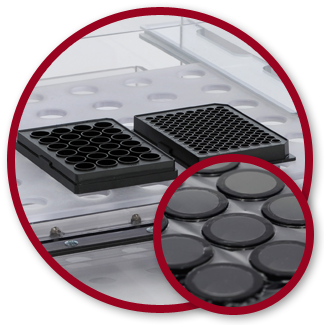
Gas Permeable Plates
Controlled O2 levels from your incubator, glove box or cabinet transfer directly to the microenvironment of the cells growing on the gas permable membrane. Provides faster equilibration times and ideal for intermittent hypoxia studies where the cell microenvironments must change in response to rapid cycling of gaseous O2 levels.
Cells “Experience” Controlled O2 Levels
It has been shown that culturing cells at 18-21% O2 (ambient conditions) yields altered phenotypes and gene-expression compared to culturing at physiologic levels.1,2,3 Additionally, abnormally low O2 has been shown to be responsible for pathophysiology.
Consequently, the need for cellular studies to be done at biologically relevant pericellular levels of O2 has become apparent. Unfortunately pericellular O2control with standard plates and incubation techniques is challenging. Gaseous O2 levels are a poor indicator of pericellular O2 levels due to the long diffusion times needed to equilibrate media with the gaseous O2 level coupled with the potential of cellular O2 consumption exceeding the diffusion.4,5,6,7
The Coy Permeable Plates take advantage of historically proven technology by changing the design of the multi-well plates to enable adherent cell microenvironments to be at controlled physiologic O2 levels.
Perfect for Imaging, UV analysis or automated measurements
Film has unique set of properties enabling support of cell physiology & sophisticated imaging technology.
- High Resolution Live Cell Imaging
- Fluorescence Resonance Energy Transfer (FRET)
- Fluorescence Recovery after Photobleaching (FRAP)
- Laser Scanning Confocal Microscopy (LCM)
- Low Intensity Fluorescence
Gas Permeable Membrane Replaces Bottom of the Wells
Tissue Culture Surface
- Well-established plasma surface modification includes amination
- Suitable for growing most adherent cells (e.g. HEK U293, HepG2, MCF-7)
- Coating with extra cellular matrix proteins is recommended for some very sensitive cell lines (e.g. PC-12) and some primary cells
O2 Diffusion Slower than O2 Consumption Cells Experience Non-Desired O2 levels
- Controlled O2 Levels from your incubator, glove box, or cabinet transfer directly to the microenvironment of the O2 cells growing on the membrane
- Ideal for intermittent hypoxia studies where the cell micro- environments must change in response to rapid cycling of gaseous O2 levels
O2 Permeates the Membrane Bottom of Wells Cells Experience the Desired O2 Level
Standard Plates
Average pericellular pO2 levels of MEF cells plated at differing densities (100,000, 33,000, 10,000 and 0 cells/cm2) and exposed to A) ~19%, and B) 7% ambient pO2 as controlled by a Coy O2 Controlled Glove Box. n=3 for each treatment. 1 ml media/well. At both 19% and 7% O2, diffusion is unable to keep up with the O2 loss in media due to respiration. From Lynn (2011)7
Gas Permeable Plates
Steady-state pericellular pO2 (measured up to 24h) in confluent Hep G2 cultures in dishes with gas-permeable bottom (0.5ml medium/cm2) vs. pO2 of incubation gas (n=4). From Wolff (1993)6. [data predates existence of Coy Gas Permeable Plates]
OPTION/ACCESSORY:
Elevated Plate Holder for Solid Shelves
Holder maintains space under plate for optimum gas exchange during:
- Use on non-perforated incubation shelves
- O2 Cycling for Intermittent Hypoxia studies
Plate Holder available with and without sensor support.
Strong 25μm polymer film has high gas transfer rate while retaining liquid
- 300% elongation with blunt objects
- O2 Permeability > 9000 cm3/m2*d*bar
- CO2 Permeability > 7000 cm3 /m2*d*bar
- efractive Index – 1.34
Abbe Number – 70
Light Transmission @ 240 nm – >85% - @ 300 nm – >90% Individual Well Planarity – <10 um
- Plate Planarity – < 50 um
Literature
1 Atkuri KR, Herzenberg LA, Niemi AK, Cowan T, Herzenberg LA. 2007. Importance of culturing primary lymphocytes at physiological oxygen levels. Proc Natl Acad Sci U S A. 104(11): 4547-4552.
2 Ivanovic Z. 2009. Hypoxia or in situ normoxia: The stem cell paradigm. J Cell Physiol. 219(2): 271-5.
3 Sahaf B, Atkuri K, Heydari K, Malipatlolla M, Rappaport J, Regulier E, Herzenberg LA, Herzenberg LA. 2008. Culturing of human peripheral blood cells reveals unsuspected lymphocyte responses relevant to HIV disease. Proc Natl Acad Sci U S A. 105(13): 5111-5116.
4 Wion D, Christen T, Barbier EL, Coles JA. 2009. PO2 matters in stem cell culture. Cell Stem Cell. 5(3): 242-243.
5 Thomas PC, Halter M, Tona A, Raghavan SR, Plant AL, Forry SP. 2009. A noninvasive thin film sensor for monitoring oxygen tension during in vitro cell culture. Anal Chem. 81(22): 9239-9246.
6 Wolff M, Fandrey J, Jelkmann W. 1993. Microelectrode measurements of pericellular PO2 in erythropoietin-producing human hepatoma cell cultures. Am J Physiol. 265(5 Pt 1): C1266-1270.
7 Lynn SG, LaPres JJ, Studer-Rabeler K. 2011. Oxygen monitoring in cell cultures. Gen Engin Biotech News 31(6): 52-53.
8 de Souza N. 2007. Too much of a good thing. Nat Methods. 4(5): 386.
Some common parts and accessories are available for online purchase with credit cards only. All on-line sales are final. If ordering by P.O., please submit your P.O. to orders@coylab.com. Please note that some accessories do not fit all products.
